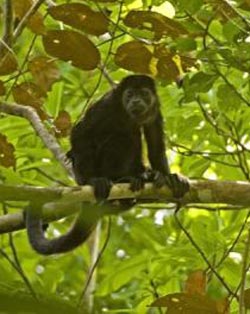Tropical arks reach tipping point

Even well-protected tropical reserves may not protect wildlife if the surrounding habitat is degraded. This howler monkey lives on Barro Colorado Island, a Smithsonian research station in the Panama Canal waterway.<br><br>Credit: Smithsonian Tropical Research Institute<br>
“Biodiversity is declining rapidly at reserves including Kahuzi Biega in the Democratic Republic of Congo, Xishuangbanna in southern China, and Northern Sierra Madre in the Philippines, among others,” said Laurance. “Reserves that are doing relatively well include Bwindi Impenetrable N.P. in Uganda, Santa Rosa in Costa Rica, and Los Amigos in Peru.”
Laurance asked experts who study plant and animal life across the Americas, Africa and Asia-Pacific to rate the effectiveness of the reserves where they have worked over the last two to three decades. Smithsonian coauthors include STRI staff scientist Joe Wright, and John Kress, Mercedes Foster and Louise Emmons at the National Museum of Natural History. They rated reserve health based on changes in abundance of 31 different groups from trees to primates.
“Reserves are like arks for biodiversity,” said Laurance, “But some are in danger of sinking.”
Even well-protected reserves mirror changes in surrounding landscapes. On the Smithsonian's Barro Colorado Island research station in Panama researchers recorded slight increases in exotic animals and plants.
Reserves suffering the most were those were encroached upon by illegal colonists, hunters and loggers. The bottom line, researchers say, is that we need to do a better job of protecting protected areas.
The Smithsonian Tropical Research Institute, headquartered in Panama City, Panama, is a unit of the Smithsonian Institution. The Institute furthers the understanding of tropical nature and its importance to human welfare, trains students to conduct research in the tropics and promotes conservation by increasing public awareness of the beauty and importance of tropical ecosystems. Website: www.stri.si.edu.
Reference: Laurance, William F., and 215 coauthors. 2012. Averting biodiversity collapse in tropical forest protected areas. Nature, DOI:10.1038/nature11318. Published online on 26 July 2012.
Media Contact
All latest news from the category: Life Sciences and Chemistry
Articles and reports from the Life Sciences and chemistry area deal with applied and basic research into modern biology, chemistry and human medicine.
Valuable information can be found on a range of life sciences fields including bacteriology, biochemistry, bionics, bioinformatics, biophysics, biotechnology, genetics, geobotany, human biology, marine biology, microbiology, molecular biology, cellular biology, zoology, bioinorganic chemistry, microchemistry and environmental chemistry.
Newest articles

Superradiant atoms could push the boundaries of how precisely time can be measured
Superradiant atoms can help us measure time more precisely than ever. In a new study, researchers from the University of Copenhagen present a new method for measuring the time interval,…

Ion thermoelectric conversion devices for near room temperature
The electrode sheet of the thermoelectric device consists of ionic hydrogel, which is sandwiched between the electrodes to form, and the Prussian blue on the electrode undergoes a redox reaction…

Zap Energy achieves 37-million-degree temperatures in a compact device
New publication reports record electron temperatures for a small-scale, sheared-flow-stabilized Z-pinch fusion device. In the nine decades since humans first produced fusion reactions, only a few fusion technologies have demonstrated…





















